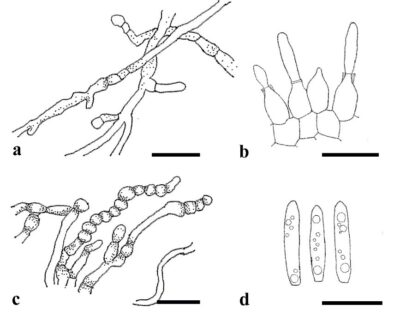Fungalpedia – Note 351, Neocylindroseptoria
Neocylindroseptoria Thambug. & K.D. Hyde
Citation when using this data: Tibpromma et al. 2024 (in prep.) – Fungalpedia, Parasites.
Index Fungorum, Facesoffungi, MycoBank, GenBank, Fig. 1
Classification: Botryosphaeriaceae, Botryosphaeriales, Incertae sedis, Dothideomycetes, Pezizomycotina, Ascomycota, Fungi
Quaedvlieg et al. (2013) initially proposed a new species, Cylindroseptoria pistaciae, to Cylindroseptoria due to pycnidial conidiomata instead of cupulate conidiomata. Later, Thambugala et al. (2014) revised and established a new genus Neocylindroseptoria to accommodate Neocylindroseptoria pistaciae (Cylindroseptoria pistaciae) based on phylogenetic analysis of a combined dataset of ITS, SSU, and LSU gene regions. Neocylindroseptoria is described by black, erumpent, pycnidial, globose, separate conidiomata, with a central ostiole; peridium of 3–6 layers of brown textura angularis; phialidic, monophialidic, or polyphialidic conidiogenous cells bearing hyaline, smooth, cylindrical, straight to curved, aseptate, subobtuse conidia; conidia apex subobtuse, base truncate, and guttulate (Crous et al. 2013, Quaedvlieg et al. 2013). Quaedvlieg et al. (2013) introduced the holotype Neocylindroseptoria pistaciae from symptomatic leaves of Pistacia lentiscus in Spain but without more useful information on pathogenicity. However, this genus was synonymous with Dothiora by Crous et al. (2018).
Type species: Neocylindroseptoria pistaciae (Quaedvl., Verkley, & Crous) Thambug. & K.D. Hyde
Current name: Dothiora pistaciae (Quaedvl., Verkley & Crous) Crous
Other accepted species: Species Fungorum – search Dothiora
Figure 1 – Morphology of Neocylindroseptoria. a, c Intercalary chains of chlamydospore-like cells. b Conidiogenous cells. d Conidia. Scale bars: a, c = 15 μm, b, d = 10. Redrawn from Crous et al. (2013).
References
Entry by
Yang EF, Department of Biology, Faculty of Science, Chiang Mai University, Chiang Mai 50200, Thailand; Center for Yunnan Plateau Biological Resources Protection and Utilization, College of Biological Resource and Food Engineering, Qujing Normal University, Qujing, Yunnan 655011, China.
(Edited by Saowaluck Tibpromma, Samaneh Chaharmiri-Dokhaharani, & Achala R. Rathnayaka)
Published online 14 November 2024
